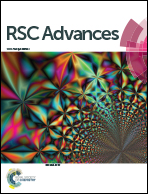Porous acrylate monolith supported Pd nanoparticles: highly active and reusable catalyst for Suzuki–Miyaura reaction in water
Abstract
The present work describes the use of palladium-Schiff-base functionalized methyl methacrylate-glycidyl methacrylate (MMA-GMA) copolymer monoliths for the SMC reaction of aryl halides in water under aerobic conditions. Highly porous MMA-GMA copolymer monoliths with interconnected network morphology have been fabricated by a thermally induced phase separation technique (TIPS). The copolymer synthesized here via radical polymerization has a molecular weight of 162 000 and GMA content of 11 mol%. The monoliths have been functionalized by aminolysis of the epoxy groups by ethylene diamine, followed by their condensation with salicylaldehyde to form the Schiff base. The donor atoms of the Schiff base bind Pd(II) ions very efficiently to generate an ortho-metallated Pd(II)–Schiff base complex anchored on acrylate copolymer monoliths (Pd-SBAM). The material has been found to exhibit excellent catalytic activity, high stability and turn over frequency (TOF) for SMC reactions. The biphenyl products have been obtained with very high yield and the catalyst could be reused for several reaction cycles without significant loss of its activity. Moreover, the heterogeneous catalyst has been developed in the form of a monolith, which facilitates its easy separation from the reaction medium.


 Please wait while we load your content...
Please wait while we load your content...